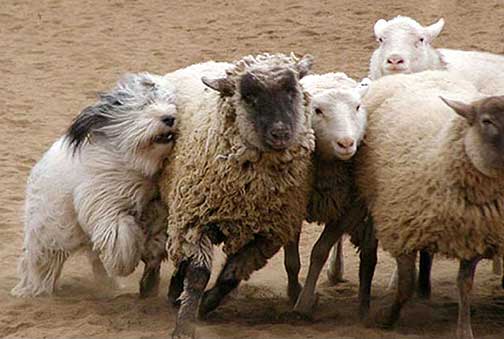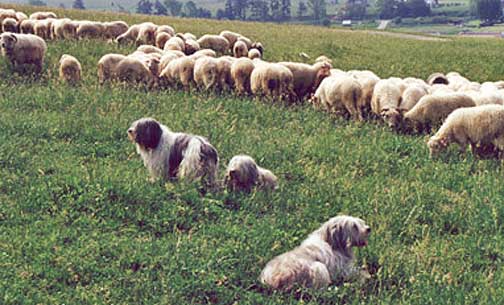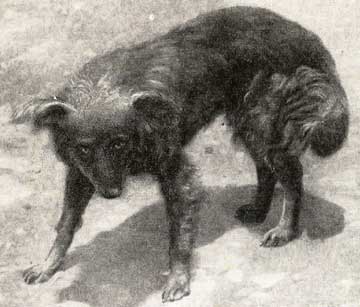

![]()
HERDING DOGS OF EASTERN EUROPE
THE HERDING DOGS OF POLAND
A Polish Lowland Sheepdog herding sheep.
(Photo kindly provided by Lynne Zubrzycki of Domlina Poms.)
Forests cover about 30.5% of Poland's land area, making it the 4th most forested country in Europe, and the forests are expanding. The earliest records of sheep production date back to the 13th century. Introduction of a free-market economy in 1989 resulted in the breakdown of Polish agriculture as well as decreasing livestock numbers; and a global overproduction of wool devistated the sheep industry. In Poland, most private farms are small and short of pasture, averaging about 15 acres and producing both crops and livestock. Sheep are housed all year round, though I believe they must be pastured during the day in summer.
The southern mountain provinces still boast large numbers of sheep grazing open range. All the farmers in a village put their sheep together to send to the mountains, many having fewer than ten animals to contribute to the flock. The sheep spend from May to September in the mountains and return to their farms in the fall.
Polish Lowland Sheepdog or Polski Owczarek Nizinny
 Three PONs among a flock of sheep. (Photo by Dziechcinek.)
Three PONs among a flock of sheep. (Photo by Dziechcinek.)
Like the Russian Ovcharka, the Polish Lowland Sheepdog (PON) resembles the Old English Sheepdog (OES), so closely that it has been suggested that the OES developed from it. PON histories say that six PONs were brought to Scotland to fetch a shipment of sheep in 1514 and the Scottish shepherd was so impressed with them that he bought three of them on the spot. It could have been the other way around. Either may have contributed to the other's gene pool, or not, but both breeds, and bearded breeds from other countries, developed from bearded-coated types in their own countries and their coats were exaggerated by breeding in modern times. It might also be said that the PON is a relative of the Ovcharka, and like the Ovcharka, used to be a more moderately-coated dog, some individuals like a moderate-rough-coated Border Collie (that von Stephanitz calls "smooth-coated"), and others like the old Bearded Collies. The PON has been known in Poland from at least the 13th century. Still, like most other breeds, its proponents look for an even more ancient origin and have picked the Nomadic tribesmen of Tibet, Mongolia, and the Gobi desert as bringing the progenitors of the PON west, and crossing them with the Hungarian Puli. The origin of this breed might indeed be in Asia, as many believe, and, may indeed have been crossed with the Hungarian Puli. But such crossings probably happened in more modern times. Whatever its origin, the PON is well-adapted to the harsh climate and rugged terrain of Polish farmland, and can probably be considered a Polish landrace breed today.
 A "smooth-coated Polish sheepdog". (Photo from von Stephanitz.)
A "smooth-coated Polish sheepdog". (Photo from von Stephanitz.)
The PON is a medium-sized dog with a heavy double coat. They come in white, grey or brown with white, black, gray or brown markings, and are 18-20 inches in height. Their tail is long, naturally bobbed, or docked. They work as herder, guardian, and watchdog. The PON utilizes bark to flush sheep out of woods and gather the flocks off the mountainsides, and otherwise uses shoulder bumps and nudges. In moving big flocks, especially through towns and villages, shepherds may walk at the front and back, with the dogs patrolling the flanks.
The breed was almost driven to extinction during World War II, but brought back from the brink in the 1950s by Dr. Danuta Hryniewicz, a veterinarian, and her PON "Smok", who is now considered the father of the breed. Today, the PON can be seen in most performance activities, and show.
Copyright © 2014 by Carole L. Presberg
Resources:
Schoenian, Susan. "Six months in Poland with a Maryland County Agent", International Experiences (www.sheepandgoat.com/articles/poland.html).
Von Stephanitz, Capt. Max. The German Shepherd Dog, originally published ca. 1918 in German; 8th edition published in German in 1932; English edition of 8th edition published 1947, published by Verein für deutsche Schäferhunde.
Wikipedia: "Agriculture in Poland" (en.wikipedia.org/wiki/Agriculture_in_Poland).
Wikipedia: "Poland" (en.wikipedia.org/wiki/Poland)
Wikipedia: "Polish Lowland Sheepdog" (en.wikipedia.org/wiki/Polish_Lowland_Sheepdog).
Return to
![]()
BORDER COLLIE COUSINS
THE OTHER WEB PAGES WE MAINTAIN
These web pages are copyright ©2014
and maintained by webmeistress Carole Presberg
with technical help from webwizard David Presberg
ALL RIGHTS RESERVED
If you are interested in using ANY material on this website, you MUST first ask for permission.